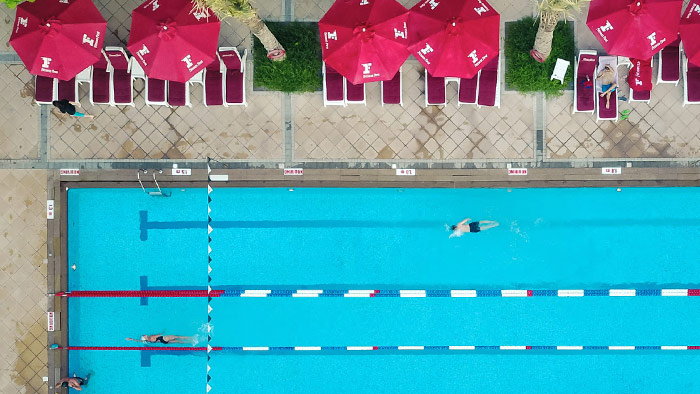My family is on vacation in northern Wisconsin where we own a small fishing cabin, and I needed a pool swim. Badly. It’s summer in the U.S. for crying out loud, how hard could it be to find some lane lines?
Normally I’d go to the nearby high school. It educates the local youth plus the kids from the Ojibwe people of the Lac du Flambeau tribe, and has a nice 25-yard pool. The facility is about 23 miles away, but was (surprisingly) closed for remodeling.
I guessed it to be about 40 miles to the nearest YMCA. But I really wanted to swim since I have a 5K event in Lake Michigan in five weeks.
So, I made the drive to the Y and clocked it at 46 miles, although I wasn’t quite sure where I started. Did I remember to zero the odometer? As it turns out, the answer was no, for on my second trip, after zeroing the odometer in the driveway, I parked at the Y with 53.5 miles showing.
“Jeez that’s a long way. Was my swim workout really worth it?” YOU BET! I’d easily drive a measly 53 miles if it meant 4,300 uninterrupted yards of chlorine-scented bliss. The box was checked, and I could continue with my family bonding time in the right frame of mind.
As a triathlete, you know that feeling. You’re on holiday but the situation does not lend itself to you matching your pre-selected training requirements. You’re in sync with the family, but a little edgy—not as relaxed as you could be. Your logbook beckons, but you think there’s not much you can do about it. Basically, you’re one tooth off.
Actually, there’s a good bit you can do about it. As you might suspect, there’s a little prior planning involved. OK, there’s a fair amount of prior planning involved but it is so worth it during your week’s vacay. This is especially true when, even after a vacation, you can toe the line at your next important race with no real gaps in your training.
First, let’s assume you’re an athlete who uses some type of periodization model and can schedule your recovery week to match your vacation. You bust it for the two weeks before departure. So far so good. Then, depending on the type of vacation planned, relaxing at Aunt Emily’s house in the suburbs versus white water rafting the Colorado River down the Grand Canyon, different settings require different plans.
Let’s pick something in the middle and assume your prior week will be pretty hard. So, in addition to the away from the office time allowing you to mentally back off, you can physically back off as well. Remember, this is recovery. Many if not most triathletes allow snippets of the sport to slip into the forefront of their minds many times per day. Although this won’t stop while traveling, you can’t turn off who you are, perhaps it can be shifted into the backseat of one’s brain for just this week.
Second, let’s define the available training resources at your destination and pick three key workouts, one for each discipline, to allow you to grade the week a workout success.
If you get these, anything else is gravy. Discuss this with your spouse who, already living with you (thus living with triathlon on a daily basis), understands their importance.
Promise not to be a time hog, though. Running can be done anywhere so you can figure that one out. As for swimming, if you need a pool, try usms.org/placswim, but call them before you leave to make sure the website has up-to-date information.
You might also see if there’s a nearby open-water race which would be just a perfect coincidence! There’s a good chance you’ll be away from home but your bike will not be and you’ll have to make do.
There are over 2,700 YMCAs in the U.S. and it’s hard being more than an hour from one of them. They have spin bikes (and pools) galore. Even though it’s not perfect, two-plus hours on a stationary bike at the Y beats two-plus hours watching Dora the Explorer re-runs with the kids. Consider a borrowed bike or one rented from the local bike shop you called a month ago—again this is where planning ahead becomes crucial.
Many types of alternative or dry land exercise can be good substitutes to swim-bike-run from stand-up paddleboarding, CrossFit, circuit training with push-ups, box jumps, burpees and the like, to weights or even stretch cords. As with the other recommendations, setting it up a month in advance pays dividends.
A couple more things to remember about vacation. We don’t have nearly as much dietary control as we do at home and there’s inevitable weight gain. Anticipate it on your initial weigh in once home.
The good news is that once back to your normal schedule, the tonnage departs fairly quickly. Remember that this can also be a great opportunity for extended, high-quality sleep.
A chance to refresh, to even store up a little badly needed rest. Not having the need to combine work and sleep may even allow a couple days where the alarm clock isn’t even considered. This is a true bonus so take advantage of it. In summary:
- Planning ahead for your vacation workout needs improves your chances of success and having a mellow approach toward each day.
- If you identify three key workouts for the week, and discuss their importance with your spouse ahead of time, you’re more likely to consider the week a tri success.
- Match your periodization with vacation such that it’s a recovery week requiring a lower training commitment.
- Note that with a loss of control of your diet, you will likely gain weight while away from home. Plan this into your life and your first couple weeks home to ensure racing weight success.



